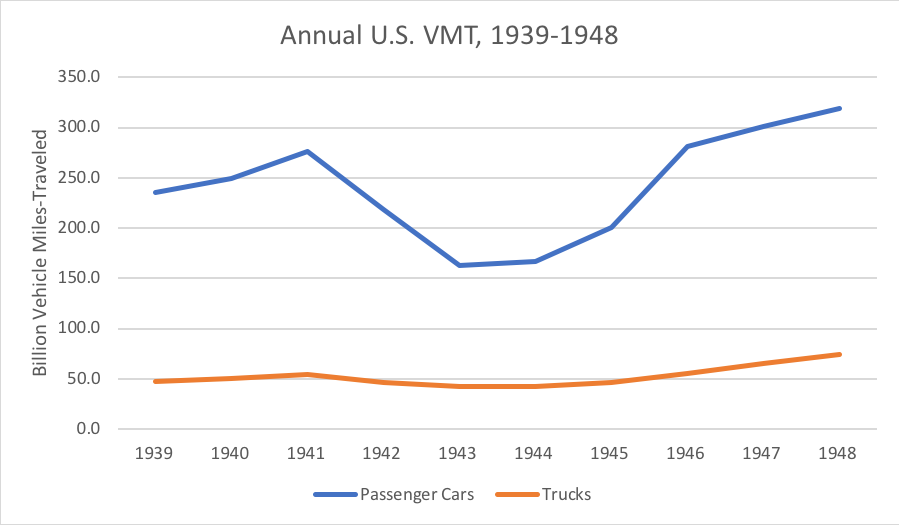By Jeff Davis, Eno Center for Transportation, April 8, 2020
“No one is quite sure how much vehicle miles-traveled (VMT) has decreased [as a result of pandemic stay-at-home orders]. All we have so far are estimates based on anonymized cell phone data and some anecdotal information from toll bridge and turnpike collections. But a drop of at least 40 percent in non-truck VMT would not be surprising.

“[For] some precedent into what happens when government forces a drastic reduction in VMT … the World War II experience in gasoline rationing may provide some interesting parallels.
“WWII gas rationing was never really about saving gasoline. The U.S. had plenty of oil production and refinery capacity as of 1941. The problem was rubber. Natural rubber was (and is to this day) the only way to make high-pressure airplane tires.
“FDR ordered gasoline rationing in the 17 Eastern Seaboard states on May 12, 1942 [as a way to save rubber. But] a blue-ribbon panel [appointed by the president and] headed by Bernard Baruch [reported that] ‘Gas rationing is the only way of saving rubber. Every way of avoiding this method was explored, but it was found to be inescapable. That is why the restriction is to be nationwide. Any localized measure would be unfair and futile.’
“Accordingly, President Roosevelt ordered the gas rationing program extended to the whole country on November 6, 1942, with the effective date later postponed to December 1, 1942.
“But once gas rationing in the East started in mid-May, the results were obvious.
| 1st Half of May 1942 (vs 1941) | 2nd Half of May 1942 (vs 1941) | |
| Non-rationed States | -13.6% | -16.9% |
| Rationed States | -18.0% | -45.0% |
| U.S. Total | -15.9% | -31.5% |
Nationwide “passenger car VMT in 1943 [showed] a 43 percent reduction from the 1941 peak. VMT started to pick up in 1945 as the war wound down. Truck traffic also dropped, but not so sharply — a 15 percent drop in 1942 followed by another 9 percent drop in 1943.”

The full article presents interesting data, including a considerable bonus effect on safety:
“The drop in VMT, the removal of most single males ages 18-35 from the pool of domestic drivers, and the nationwide 35 mile an hour speed limit imposed by the Office of Defense Transportation in September 1942 all had a marked effect on traffic safety during World War II. Highway fatalities dropped from just over 38,000 in 1941 to around 23,000 per year in 1943 and 1944.”

